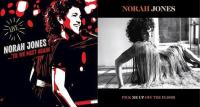Pick Me Up Off the Floor and ...'Til We Meet Again—A Norah Jones "Twofer" Review
Jones's self-produced seventh album in her twenty year career that began with the mega-hit Come Away With Me is a low key, introspective collection of mostly self-penned tunes that are more blues and pop-oriented and less jazzy. With song titles that include "How I Weep", "Hurts to Be Alone", Heartbroken, Day After", it's easy to hear it as a "break-up" album, but the songs dig deeper and the themes are often more multi-dimensional than strictly personal and some are more abstract than literal.
Nonetheless there's no escaping the mostly downcast, "get me out of here" mood, which is completely understandable in the past few years' undeniably unsettled environment. Two collaborations with Jeff Tweedy, "I'm Alive" and "Heaven Above" produce rare moments of resiliency in the otherwise melancholic proceedings with a basic piano, bass and drums trio of revolving players augmented by horns, strings, pedal steel, Hammond B-3 organ and background singers. Other than the opener "How I Weep", which features a full string section all of the arrangement are for small groupings, dryly recorded, which keeps the musical environment intimate. Even the opener tucks the strings in and keeps them from dominating. The versatile, always interesting drummer Brian Blade plays on half a dozen tunes, and of course the Tweedy collaborations are guitar-laced and add a folk-drive.
So subtly drawn is this album, so delicately delivered are the dewdrop arrangements that it might take more than a few listenings for it to fully draw you in but once it does, the parts fit well together and the ingenuity of the arrangements will register. I'm thinking in particular of "It Hurts to Be Alone", which includes an ingenious mix of subtle, easy to miss elements hiding in plain sight.
Not to worry though, as Jones sings on "Heartbroken Day After"—"Oh, hey, hey/It's gonna be okay/My little one/I promise/We'll find our way/Hey, Hey/Don't look so worried/We'll have to hurry/And climb out of this mess we've made."
Despite many parts being "flown in" from outside studios, the overall sonics are coherent and pleasing, if somewhat dry. Turn up the volume and dig Blades' subtle sound!.
More recently Jones released Norah Jones ...'Til We Meet Again a globetrotting two LP live, career covering album recorded between 2017 and 2019 in eight venues in California, France, Brazil, Argentina, Italy and the closer, an intense, heartfelt solo cover of Chris Cornell's classic "Black Hole Sun", recorded in Detroit's Fox Theater a few days after his surprising death by suicide.
These trio and quartet recordings make for an ideal introduction to Norah Jones' exceptional musicianship and performance chops not to mention her deep audience connection, especially considering that she's not the most demonstrative live performer. Theres' little patter and even less audience engagement other than where it counts. Clearly the audiences loved these performances.
The problem for home listeners is that these are clearly board mixes so rather than producing the kind of "stage intimacy" created by the best live recordings where you feel as if you are either on stage or in the first few rows, the sound puts you well back in the audience soaked in the sound reinforcement reverb.
The Weavers or Belafonte at Carnegie Hall sound it's definitely not!
The "sound reinforcement" kind of presentation works better (if it works at all) for rock than it does for jazz/folk so you may not find the sonic experience all that enticing, though Jones's performances and those of her group might get you past the less than intimate board mixes.
On the other hand, if you miss the feel of being in the audience at a live concert, here you go—and it would be a shame to miss her version here of "Sunrise" recorded in Buenos Aires because it's spectacular so at least stream that and then maybe you'll want to buy the album.! (Note: the music rating is for both albums, the sound rating is for "PMUOTF")




